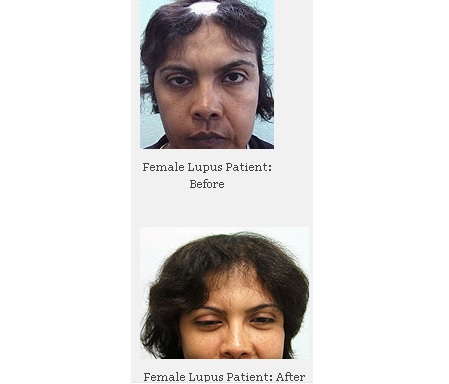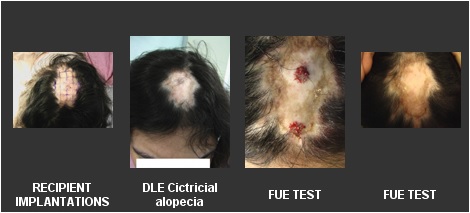
Below is an example of a typical case that was managed under this program. If, after reviewing the case, you truly think you might qualify for our Indigent Treatment Program, drop us a note.
Besides Male Patterned Baldness (MPB), there are myriads of other dermatologic conditions that cause hair loss. A typical dermatology clinic would see these conditions either as a result of self referral or often times from other hair transplant surgeons. Many of these conditions are inflammatory in nature. Some of these conditions if not recognized and treated early could result in scarring with permanent hair loss. Lupus Erythematosus –LE (popularly referred to as “Lupus”) is one such condition. Hair loss with scarring (cicatricial alopecia) is often the result of lupus, and if left unchecked could result in disfiguring lesions especially in the scalp and face.
The following patient has a diagnosis of Lupus that has resulted in problematic scarring in the face as well as the scalp (cicatricial alopecia). She is being treated at DermHair Clinic “Complementary Treatment Program:
Scarring Alopecia

At the time of presentation, the patient had been with LE condition for several years. It started with sun sensitive expanding inflammatory lesions that later became scarred. In the scalp, it resulted in hair loss in the affected areas.
She has been on lupus medications that consisted of injectibles, oral medications and topicals at the time of presentation. Upon presentation we took biopsies at strategic areas of the lesion and reformatted her treatment to suit the survival of hair grafts post transplantation.
Our findings upon examining the histologic slides encouraged us to proceed with plans for hair transplantation as a viable option.
First an FUE test session was done on two separate foci of the scalp lesion 3 MONTHS PRIOR ~50 grafts were shared between the two foci.
Donor Harvesting
In female FUE patients especially, hair length and volume tends to be a concern, the nature and extent of hair shaving options and downtime implications(if any) must be discussed ahead of time. In this patient, the recipient area was not at issue.
The merits and demerits of different options were discussed; The patient felt comfortable with having the extent of her “safe zones” shaved since she has adequate hair length and volume, both above and below these areas to cover the area in the weeks it would take for hair re-growth to catch up to pre-surgical states. Doing this also enables better spacing of extraction sites as well as a higher graft yield per session.
Months and Counting
It takes 9-12 months for the cosmetic result of a typical hair transplant to manifest. This patient is being seen every month. We had the opportunity of taking some photos at her 2 month visit. At this point the following are of interest:
- Yield
- Donor healing thus far
- Donor hair re-growth (a very important issue for a woman)
- Signs of Lupus activity
Have questions about hair loss? Ask Dr Umar

